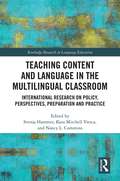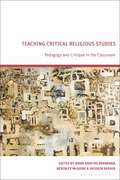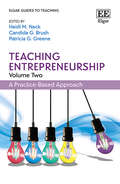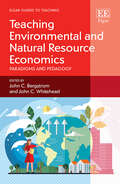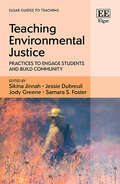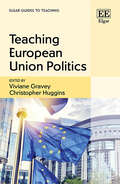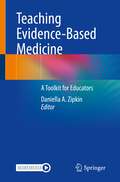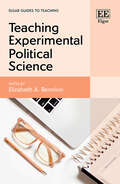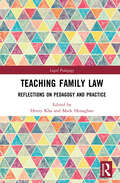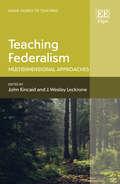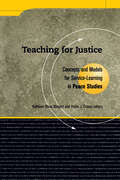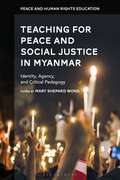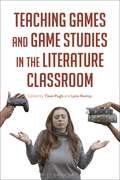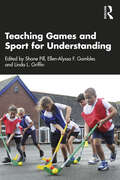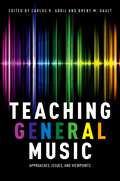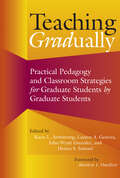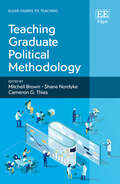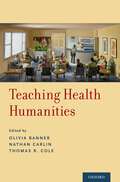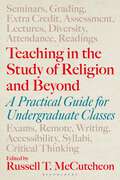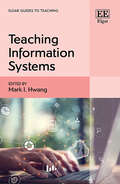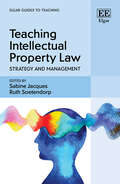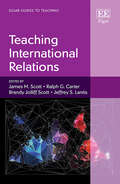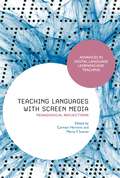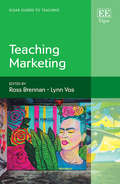- Table View
- List View
Teaching Content and Language in the Multilingual Classroom: International Research on Policy, Perspectives, Preparation and Practice (Routledge Research in Language Education)
This book brings together research from six different countries across three continents where teacher educators and policy makers are addressing the under-preparation of content teachers to work effectively with multilingual learners. By highlighting this relatively young field of research at an international level, the book advances the research-based knowledge of the field and promotes international research relationships and partnerships to better support the education of multilingual learners and their teachers. The chapters represent high-quality empirical qualitative, quantitative, and mixed methods studies about pre-service and in-service teachers. Comprising four sections, each represents a critical aspect of the equitable teaching of multilingual learners. All the research was conducted in countries that belong to OECD (Organisation for Economic Co-operation and Development) and the PISA (Programme for International Student Assessment) enabling the reader to compare contexts and outcomes. This book will be of particular interest to academics, researchers, and post-graduate students in the fields of language education, teacher education, and education for multilingual learners. It will be of great value to anyone concerned with equity and social justice for multilingual learners whose languages, cultural practices, and resources are often overlooked and/or marginalized in the schools they attend.
Teaching Critical Religious Studies: Pedagogy and Critique in the Classroom
Are you teaching religious studies in the best way possible? Do you inadvertently offer simplistic understandings of religion to undergraduate students, only to then unpick them at advanced levels? This book presents case studies of teaching methods that integrate student learning, classroom experiences, and disciplinary critiques. It shows how critiques of the scholarship of religious studies-including but not limited to the World Religions paradigm, Christian normativity, Orientalism, colonialism, race, gender, sexuality, and class-can be effectively integrated into all courses, especially at an introductory level. Integrating advanced critiques from religious studies into actual pedagogical practices, this book offers ways for scholars to rethink their courses to be more reflective of the state of the field. This is essential reading for all scholars in religious studies.
Teaching Entrepreneurship, Volume Two: A Practice-Based Approach (Elgar Guides to Teaching)
Building on the success of the first volume of Teaching Entrepreneurship, this second volume features new teaching exercises that are adaptable and can be used to teach online, face to face or in a hybrid environment. In addition, it expands on the five practices of entrepreneurship education: the practice of play, the practice of empathy, the practice of creation, the practice of experimentation, and the practice of reflection. This portfolio of practices leads to a holistic teaching approach designed to help students think and act more entrepreneurially under various degrees of uncertainty and across contexts. Here in Volume Two the editors and contributors demonstrate how the five practices are a framework for course development to help students make progress toward a more entrepreneurial way of thinking and develop the ability to find and create new opportunities with the courage to act on them. Educators trying to build entrepreneurship into their curriculum, from within and outside the business school, will find Teaching Entrepreneurship, Volume Two invaluable in developing experiential learning experiences.
Teaching Environmental and Natural Resource Economics: Paradigms and Pedagogy (Elgar Guides to Teaching)
Teaching Environmental and Natural Resource Economics is a significant contribution to the literature of economics education. Theory and practice, teaching activities and exercises, and pro teaching tips are clearly and expertly presented.The editors begin by presenting a bit of the historical thought on the study of environmental and natural resource economics. Once the editors establish context, they provide a full exploration of both paradigms and pedagogy. The paradigm section provides models for teaching the variety of courses offered at the university level. The chapters bridge the gap between environmental and natural resource economics textbooks and the classroom, with guidance for how to approach course topics. The pedagogy section is an excellent contribution to the teaching of environmental and natural resource economics, covering both particular topics and teaching methods.University instructors will find this guide to teaching environmental and natural resource economics invaluable in helping students gain a better understanding of the theory and practice of environmental and natural resource economics.
Teaching Environmental Justice: Practices to Engage Students and Build Community (Elgar Guides to Teaching)
This ground-breaking book presents interdisciplinary educators with classroom tools and strategies to integrate environmental justice into their courses. Providing accessible, flexible, and evidence-based pedagogical approaches designed by a multidisciplinary team of scholars, it centers equity and justice in student learning and course design. It further presents a model for community-based faculty development that can communicate those pedagogical approaches across disciplines.Key Features:Reflection on how to teach inclusively across disciplines, with a focus on community-based faculty development.Presentation of a blend of insights from diverse disciplines, including art, astronomy, ecology, economics, history, political science, and online education.A focus on how to stimulate student engagement to improve students’ empirical and conceptual understanding of environmental politics.Detailed instructions for both introductory and more advanced active learning assignments and classroom activities, including guidance on how to manage common challenges and adapt activities to specific learning environments, particularly online formatsProviding detailed instructions and reflections on teaching effectively and inclusively, Teaching Environmental Justice will be an invaluable resource for faculty and graduate students teaching modules in environmental justice in courses across disciplines. It will also be essential reading for researchers of teaching and learning seeking insight into cutting-edge classroom practices that center equity and justice in student learning.
Teaching European Union Politics (Elgar Guides to Teaching)
Why do we teach EU politics? What should EU politics students learn? What are the practical approaches and techniques to teaching EU politics? In response to these questions, Teaching European Union Politics analyses the interdisciplinary nature of teaching this broad subject and reflects on a wide range of educational approaches. It both advances the pedagogy and practice of teaching EU politics, and provides practical support for those looking to adopt innovative and learner-oriented techniques.Bringing together contributions from a number of leading experts from across Europe, this book’s comprehensive chapters focus on topics including comparative politics, international relations, history, law, policy and economics. In assessing diverse teaching techniques, such as problem-based learning, games, simulations, and study visits, it invites teachers to rise to the challenge of bringing critical perspectives into the classroom. The book asks teachers to consider how they should (re)shape their teaching practice to better equip students with a range of skills and knowledge for today's turbulent world.Providing detailed support for course development, this progressive book will prove essential for teachers and academics in European politics and policy, European studies, public policy, and international relations.
Teaching Evidence-Based Medicine: A Toolkit for Educators
Practicing evidence-based medicine is widely regarded both as best clinical practice, and as the cornerstone of meeting the ACGME competencies in Practice-Based Learning and Improvement. Training programs recognize the need to teach the skills of EBM and yet struggle with readily available content and guidance on putting together a curriculum. Time frames for delivering curricula in residency can be very tight, often restricted to scattered one hour conferences. This book provides a modular curriculum structure for instructors, with each topic area taking up one section, or one hour of instructional time. Developed over the past 14 years as an introductory course for interns in the internal medicine residency program at Duke, the curriculum will cover core content areas in evidence-based medicine and best teaching practices for them and skills such as literature searching and applying evidence to patients. Most importantly, it will center on actual patient questions and use current literature as examples that instructors can use as teaching exercises. There will also be ample diagrams that have been shown to be effective with learners and each module will include a video tutorial of a sample teaching session, including visual aids and small group teaching techniques. The curriculum can be implemented in any time frame necessary, compressed or longitudinal, to a variety of learners. This is an ideal guide for residency program directors and core faculty, either within internal medicine or more broadly in family medicine, pediatrics, surgery, OB-gyn, as well as medical school faculty for use with students.
Teaching Experimental Political Science (Elgar Guides to Teaching)
This insightful book delivers a wealth of innovative ideas, models, examples, and advice for teaching experimental political science in the classroom and beyond, emphasising that teaching experimental research is necessary to prepare students to succeed as researchers, practitioners, active citizens and civic leaders. It illustrates how teaching experimental methods sparks students curiosity by allowing them to ask and answer questions about the world they live in.With a core focus on successfully engaging a diverse range of students at all levels, this book includes a variety of approaches from contributing authors who are leading scholars in their field. Chapters provide both new and experienced teachers with concrete guidance on how to: facilitate student-designed survey experiments, use workbooks and templates to overcome mathematical and writing anxiety; use mock Institutional Review Board (IRB) reviews to teach students about the ethics of experimental research; follow an apprenticeship model to teach students to carry out their own lab experiments; and train students to go out into the field. Proposed models of teaching are supported throughout by the latest empirical research on the science of learning.Teaching Experimental Political Science will be a key resource for faculty and staff working across a variety of educational contexts including political science, international relations, international politics, domestic politics, public administration and public policy.
Teaching Family Law: Reflections on Pedagogy and Practice (Legal Pedagogy)
This book provides a comprehensive analysis of the teaching of an eclectic range of family law topics and the unique opportunities and challenges of teaching family law in different jurisdictions from a varied international perspective. Written by leading legal scholars, the book addresses a gap in the scholarship to comprehensively and systematically analyse the teaching of family law. The first part of the book explores ways of teaching the varied range of topics under the heading of family law and captures the diverse approaches to the discipline. Chapters illustrate how the subject can be best taught in an interdisciplinary way that considers feminist perspectives and the philosophy of teaching, while encompassing legal positivism, empirical research and critical legal theory. The second part of the book examines teaching in different jurisdictions and illustrates policy and practice in Australia, New Zealand, the United States, Canada, the United Kingdom, Hong Kong and South Africa. Showcasing examples of best practice of teaching family law, the book will be an essential reading for legal scholars, as well as researchers and postgraduate students in the fields of family law and legal education.
Teaching Federalism: Multidimensional Approaches (Elgar Guides to Teaching)
Teaching Federalism presents innovative ideas for teaching a wide variety of key concepts of federalism and federal-country cases. Each chapter introduces a topic, explains its place in federalism research, and provides learning objectives, pedagogical tools, and questions for class discussions, student essays, and examinations. Evaluation and reading suggestions are included as well.The book covers twenty substantive facets of federalism important for understanding contemporary issues of federalism and federation, such as power distribution, second chambers, high courts, intergovernmental relations, fiscal federalism, multinational federalism, conflict resolution, indigenous peoples, gendered federalism, and secession. Also included are case-study examples for teaching about federalism in Germany, India, Nigeria, Switzerland, and the United States.Educators around the world who teach federalism or wish to do so will find this a wonderful resource for lesson plans on a wide variety of issues related to federalism. Students studying federalism will also find it invaluable as an introductory resource for important topics and readings on the subject.
Teaching For Justice: Concepts and Models for Service Learning in Peace Studies
Tenth in the Service-Learning in the Disciplines Series, this book shows how both peace studies and service-learning have been developing new ideas of how social learning takes place as a community process in conflict situations and what the dynamics of peace building are. The process has created a new niche in academia for preparing students to become social change agents. The enthusiasm of the contributors in this book gives the reader a new vision of what is possible on college campuses in community-based peace and service-learning at a time when there is a critical need for peace-building skills.
Teaching for Peace and Social Justice in Myanmar: Identity, Agency, and Critical Pedagogy (Peace and Human Rights Education)
Bringing together scholars and educators based in Myanmar, the USA, the UK, Denmark, and Thailand, this book presents new perspectives and research on the struggle for social justice and peace in Myanmar at this critical juncture. It shows how actors from diverse backgrounds and regions of Myanmar are drawing from their identities, evoking their agency, and using critical pedagogy to advance social justice and peace. The chapters provide the compelling life stories of the authors, specific examples of what they are doing, and insights of how their work might be applied to other contexts. The topics discussed include addressing structural violence, peace curriculum development, identity-based conflict, teaching the history of the country, promoting inclusion, civic education, critical pedagogy, teacher agency, and agendas of research funding for peacebuilding. The foreword and afterword, written by well-known scholars of Myanmar, address the relevance and importance of the book vis-a-vis the current social and political crisis following the February 2021 military coup.
Teaching Games and Game Studies in the Literature Classroom
Teaching Games and Game Studies in the Literature Classroom offers practical suggestions for educators looking to incorporate ludic media, ranging from novels to video games and from poems to board games, into their curricula. Across the globe, video games and interactive media have already been granted their own departments at numerous larger institutions and will increasingly fall under the purview of language and literature departments at smaller schools. This volume considers fundamental ways in which literature can be construed as a game and the benefits of such an approach. The contributors outline pedagogical strategies for integrating the study of video games with the study of literature and consider the intersections of identity and ideology as they relate to literature and ludology. They also address the benefits (and liabilities) of making the process of learning itself a game, an approach that is quickly gaining currency and increasing interest. Every chapter is grounded in theory but focuses on practical applications to develop students' critical thinking skills and intercultural competence through both digital and analog gameful approaches.
Teaching Games and Sport for Understanding
This new book brings together leading and innovative thinkers in the field of teaching and sport coaching pedagogy to provide a range of perspectives on teaching games and sport for understanding. Teaching Games and Sport for Understanding engages undergraduate and postgraduate students in physical education and sport coaching, practicing teachers, practicing sport coaches, teacher educators and coach developers. The contributions, taken together or individually, provide insight, learning and opportunities to foster game-based teaching and coaching ideas, and provide conceptual and methodological clarity where a sense of pedagogical confusion may exist. Each chapter raises issues that can resonate with the teacher and sport practitioner and researcher. In this way, the chapters can assist one to make sense of their own teaching or sport coaching, provide deeper insight into personal conceptualisations of the concept of game-based teaching and sport coaching or stimulate reflections on their own teaching or coaching or the contexts they are involved in. Teaching games and sport for understanding in various guises and pedagogical models has been proposed as leading practice for session design and instructional delivery of sport teaching in PE and sport coaching since the late 1960s. At its core, it is a paradigm shift from what can be described as a behaviourist model of highly directive instruction for player replication of teacher/coach explanation and demonstration to instructional models that broadly are aimed at the development of players self-autonomy as self-regulated learners –‘thinking players’. This innovative new volume both summarises current thinking, debates and practical considerations about the broad spectrumof what teaching games for understanding means as well as providing direction for further practical, pragmatic and research consideration of the concept and its precepts and, as such, is key reading for both undergraduate and postgraduate students of physical education and sport coaching as well as practicing teachers and sport coaches.
Teaching General Music: Approaches, Issues, and Viewpoints
General music is informed by a variety of teaching approaches and methods. These pedagogical frameworks guide teachers in planning and implementing instruction. Established approaches to teaching general music must be understood, critically examined, and possibly re-imagined for their potential in school and community music education programs. Teaching General Music brings together the top scholars and practitioners in general music education to create a panoramic view of general music pedagogy and to provide critical lenses through which to view these frameworks. The collection includes an examination of the most prevalent approaches to teaching general music, including Dalcroze, Informal Learning, Interdisciplinary, Kodály, Music Learning Theory, Orff Schulwerk, Social Constructivism, and World Music Pedagogy. In addition, it provides critical analyses of general music and teaching systems, in light of the ways children around the world experience music in their lives. Rather than promoting or advocating for any single approach to teaching music, this book presents the various approaches in conversation with one another. Highlighting the perceived and documented benefits, limits, challenges, and potentials of each, Teaching General Music offers myriad lenses through which to re-read, re-think, and re-practice these approaches.
Teaching Gradually: Practical Pedagogy for Graduate Students, by Graduate Students
Teaching Gradually is a guide for anyone new to teaching and learning in higher education. Written for graduate student instructors, by graduate students with substantive teaching experience, this resource is among the first of its kind to speak to graduate students as comrades-in-arms with voices from alongside them in the trenches, rather than from far behind the lines. Each author featured in this book was a graduate student at the time they wrote their contribution. Consequently, the following chapters give scope to a newer, diverse generation of educators who are closer in experience and professional age to the book’s intended audience. The tools, methods, and ideas discussed here are ones that the authors have found most useful in teaching today’s students. Each chapter offers a variety of strategies for successful classroom practices that are often not explicitly covered in graduate training.Overall, this book consists of 42 chapters written by 51 authors who speak from a vast array of backgrounds and viewpoints, and who represent a broad spectrum of experience spanning small, large, public, and private institutions of higher education. Each chapter offers targeted advice that speaks to the learning curve inherent to early-career teaching, while presenting tangible strategies that readers can leverage to address the dynamic professional landscape they inhabit. The contributors’ stories and reflections provide the context to build the reader’s confidence in trying new approaches in their his or her teaching. This book covers a wide range of topics designed to appeal to graduate student instructors across disciplines, from those teaching discussion sections, to those managing studio classes and lab sessions, to those serving as the instructor of record for their own course. Despite the medley of content, two common threads run throughout this volume: a strong focus on diversity and inclusion, and an acknowledgment of the increasing shift to online teaching.As a result of engaging with Teaching Gradually, readers will be able to:·Identify best teaching practices to enhance student learning ·Develop a plan to implement these strategies in their teaching ·Expand their conception of contexts in which teaching and learning can take place ·Evaluate and refine their approaches to fostering inclusion in and out of the classroom ·Assess student learning and the efficacy of their own teaching practices ·Practice professional self-reflection
Teaching Graduate Political Methodology (Elgar Guides to Teaching)
Providing expert advice from established scholars in the field of political science, this engaging companion book to Teaching Undergraduate Political Methodology imparts informative guidance on teaching research methods across the graduate curriculum. Written in a concise yet comprehensive style, it illustrates practical and conceptual advice, alongside more detailed chapters focussing on the different aspects of teaching political methodology. Each chapter draws on practised teaching methods covering the what, how and when for teaching political methodology with an in-depth look at systematic research methods. The book is split into four distinct sections for graduate research methods education: the approach, the foundations of research design, quantitative analysis and qualitative analysis. Chapters offer evidence-based advice grounded in the science of teaching and learning (SoTL) literature from experienced, award-winning and highly recognized instructors of political methodology. Teaching Graduate Political Methodology will be required reading for faculty wanting to establish excellent methods for challenging subjects within the fields of political science, public administration and public policies. It will also serve as a useful resource for instructors wishing to gain greater student engagement with their courses by utilising different methods.
Teaching Health Humanities
Teaching Health Humanities expands our understanding of the burgeoning field of health humanities and of what it aspires to be. The volume's contributors describe their different degree programs, the politics and perspectives that inform their teaching, and methods for incorporating newer digital and multimodal technologies into teaching practices. Each chapter lays out theories that guide contributors' pedagogy, describes its application to syllabus design, and includes, at the finer level, examples of lesson plans, class exercises, and/or textual analyses. Contributions also focus on pedagogies that integrate critical race, feminist, queer, disability, class, and age studies in courses, with most essays exemplifying intersectional approaches to these axes of difference and oppression. The culminating section includes chapters on teaching with digital technology, as well as descriptions of courses that bridge bioethics and music, medical humanities and podcasts, health humanities filmmaking, and visual arts in end-of-life care. By collecting scholars from a wide array of disciplinary specialties, professional ranks, and institutional affiliations, the volume offers a snapshot of the diverse ways medical/health humanities is practiced today and maps the diverse institutional locations where it is called upon to do work. It provides educators across diverse terrains myriad insights that will energize their teaching.
Teaching Human Geography: Theories and Practice in Thinking Geographically (Elgar Guides to Teaching)
This timely book examines advances in teaching and learning at undergraduate level from the disciplines of geography education, neuroscience and learning science. Connecting these disciplines, the chapters integrate research on how students learn and explain how to teach students to think geographically and develop a deeper understanding of their world.Questioning what it means to think geographically, the editors identify ten elements that characterize thinking geographically including the weaving of various perspectives, making connections, creating meaning through spatial thinking, relational thinking and multi-scalar thinking. The book offers a collection of turnkey exercises designed by geography educators for use in human geography courses. These insightful exercises are designed to assist with promoting geographic thinking and learning, The editors provide a matrix that serves as an outstanding resource.Teaching Human Geographymakes a unique and significant contribution to geography education as an excellent resource for instructors looking to improve their practice and facilitate learning. Addressing how geography teaching can be transformed, it will also improve undergraduates' ability to think geographically by integrating research in learning science and geography education.
Teaching in the Study of Religion and Beyond: A Practical Guide for Undergraduate Classes
Drawing on their wide experience in the undergraduate classroom, the contributors address basic but current issues in university teaching. This book provides practical commentary and invites instructors to consider how to address the learning needs of their students, while taking into account the wider structural requirements of administrations, governments, or credentialing agencies.Consisting of about forty, readable, short entries – on topics ranging from curriculum, grading, group work, digital humanities and large lectures, to learning management systems, office hours, online/remote courses, recruiting and seminars – this book provides a wealth of practical help and reassurance to teachers working with undergraduate students.This book is a valuable tool for early instructors in universities and colleges, showing them how to impact a class's success. It provides a critical background on the issues involved whilst also offering suggestions on how to navigate the competing demands on teachers.
Teaching Information Systems (Elgar Guides to Teaching)
Issues related to teaching and learning information systems (IS) concepts have received keen interest from IS academics since the discipline’s inception over 60 years ago. Bringing together cutting-edge research from over 30 international experts, Teaching Information Systems presents a timely assessment of critical issues associated with the IS curriculum, the learner, and the learning environment.Chapters take a contemporary look at the key issues related to the teaching of IS across the globe, addressing the challenges of virtual learning environments, the drawbacks of relying solely on textbooks, and current thinking on how to align the curriculum with industry needs. Drawing lessons from faculty reflection and empirical evidence, the book provides valuable insight to IS professors and administrators invested in delivering high-quality IS education, demonstrating how instructors can design and implement a relevant and practical curriculum to meet the needs of modern-day students.Exploring non-technical skills and non-traditional instructional materials, this erudite teaching guide will prove an essential resource for instructors in information systems, computer science, information science, and related disciplines. Its practical insights will also benefit researchers and consultants interested in applying IS research findings to practice.
Teaching Intellectual Property Law: Strategy and Management (Elgar Guides to Teaching)
Integral to the commercial law field, Intellectual Property (IP) knowledge is central to culture, innovation, and enterprise. Looking forward to the new academic norm, Teaching Intellectual Property Law: Strategy and Management uses experience as well as interactive, practice-based methods for teaching IP to examine the various ways through which to move on from ‘chalk and talk’ methods.Crucial to science, technology, art, fashion and creative industries as well as to business creation and management, it is unsurprising that IP surfaces in curricula within and beyond the law school. Providing multiple examples, exercises and teaching tips to identify the transferable aspects of IP teaching, this book provides educators with new approaches to tailor content delivery to their students. Focused on the profile of the contemporary learner, it invites educators to adopt new approaches to impart knowledge that will empower IP students of all disciplines, at all levels.Teaching Intellectual Property Law: Strategy and Management will be a useful resource for higher education law academics offering Intellectual Property education modules in law schools, to facilitate contemporary approaches to traditional law school content. It will also be of value to tertiary educators inspired, or instructed, to include IP education in their programmes as well as enterprise and entrepreneurship educators and trainers, to further IP relevance to enterprise and entrepreneurship.
Teaching International Relations (Elgar Guides to Teaching)
This comprehensive guide captures important trends in international relations (IR) pedagogy, paying particular attention to innovations in active learning and student engagement for the contemporary International Relations (IR) classroom.This book is organized into three parts: IR course structures and goals; techniques and approaches to the classroom; and assessment and effectiveness. It is up-to-date with teaching practices highlighted by leading journals and conferences sponsored by the International Studies Association (ISA) and the American Political Science Association (APSA). Collectively, the chapters contribute to continuing dialogues on pedagogy in the field and serve as a critical resource for faculty in IR, political science, and social science.
Teaching Languages with Screen Media: Pedagogical Reflections (Advances in Digital Language Learning and Teaching)
In recent years, the expansion of screen media, including film, TV, music videos, and computer games, has inspired new tools for both educators and learners. This book illustrates how screen media can be exploited to support foreign language (L2) teaching and learning.Drawing on a range of theories and approaches from second language acquisition, audio-visual translation, multimodality, and new media and film studies, this book provides both best practices and in-depth research on this interdisciplinary field. Areas of screen media-enhanced learning and teaching are covered across 4 sections: film and broadcast media, in-depth case studies, translation and screen media, and interactive media. With a focus on pedagogical approaches to teaching and learning Spanish, French, German, and English as a Foreign Language, Teaching Languages with Screen Media presents innovative insights in this new interdisciplinary field.
Teaching Marketing (Elgar Guides to Teaching)
Teaching Marketing prompts the reader to reflect on why marketing is taught, how it is taught and what should be included in curricula in tertiary-level programmes. The international contributors have a wide range of expertise in marketing education and provide their own perspectives on these questions while considering a variety of different points of view so encouraging the reader to develop their own opinion.Topics range from all-encompassing issues such as the importance of grounding marketing education on a sound ethical foundation, to focused explorations of how to teach subjects that marketing students typically find tricky, such as research methods, business-to-business marketing, and marketing science. The use of new classroom techniques such as business simulation games is also covered, as well as how to teach marketing theory and critical marketing.With sound advice from experienced marketing educators at both curriculum and classroom level, this book will be essential for those looking for assistance with curriculum development and programme planning in marketing.
